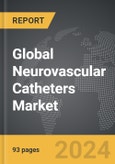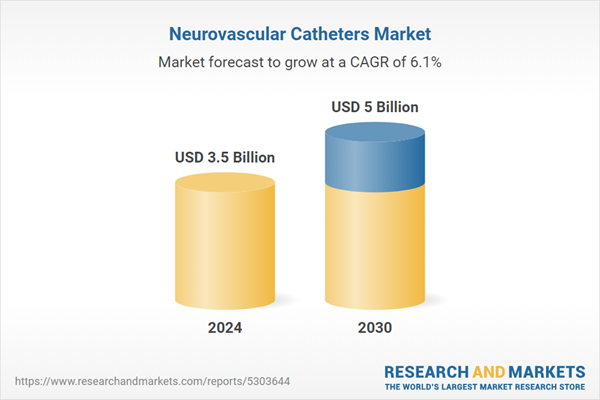Global Neurovascular Catheters Market - Key Trends and Drivers Summarized
How Are Neurovascular Catheters Transforming Neurological Interventions?
Neurovascular catheters have become essential tools in the diagnosis and treatment of cerebrovascular disorders, including strokes, aneurysms, and arteriovenous malformations (AVMs). These catheters facilitate minimally invasive procedures that are critical in reducing complications and improving patient outcomes. Used primarily in procedures such as thrombectomy, embolization, and stenting, neurovascular catheters offer high precision and control in navigating the complex vascular system of the brain and spinal cord. As neurological conditions continue to rise globally, these catheters are playing a vital role in emergency medicine, allowing for timely intervention that significantly reduces morbidity and mortality rates associated with neurovascular diseases.What Are the Key Segments in the Neurovascular Catheters Market?
Major types include microcatheters, balloon catheters, embolization catheters, and access catheters, each designed for specific interventions. Microcatheters are commonly used for selective angiography and delivering embolic agents, while balloon catheters are preferred for dilating vessels or occluding blood flow during procedures. In terms of applications, neurovascular catheters are used in ischemic stroke treatment, aneurysm repair, and AVM management. The primary end-users of neurovascular catheters include hospitals, ambulatory surgical centers, and specialized neurology clinics, all of which require advanced catheterization tools for emergency and planned neurovascular procedures.How Are Neurovascular Catheters Integrated into Modern Healthcare?
Hospitals are the largest users of neurovascular catheters, primarily in their neurology and emergency departments, where rapid intervention is critical. These catheters are essential in treating ischemic strokes, where quick recanalization of blocked vessels can significantly improve patient outcomes. Ambulatory surgical centers also utilize neurovascular catheters for planned procedures such as aneurysm coiling and embolization, offering less invasive alternatives to open surgery. Neurology clinics, focused on comprehensive stroke care and long-term neurovascular management, rely on these catheters for both diagnostic and therapeutic interventions. The growing adoption of advanced imaging techniques, such as 3D angiography and digital subtraction angiography (DSA), further supports the integration of neurovascular catheters into clinical workflows, enhancing the precision and safety of procedures.What Factors Are Driving the Growth in the Neurovascular Catheters Market?
The growth in the neurovascular catheters market is driven by several factors, including the rising incidence of cerebrovascular diseases, which necessitates timely and effective intervention. The increasing adoption of minimally invasive procedures in neurology, due to their reduced recovery times and lower risk of complications, is boosting the demand for neurovascular catheters. Technological advancements, such as the development of more flexible, trackable, and durable catheter materials, have enhanced procedural success rates and patient outcomes, further driving market growth. Additionally, government initiatives to improve stroke care infrastructure and promote early intervention are contributing to the expanded use of neurovascular catheters. The growing awareness of stroke symptoms and the need for rapid treatment are also propelling the demand for neurovascular catheterization in both developed and emerging markets.Report Scope
The report analyzes the Neurovascular Catheters market, presented in terms of market value (US$ Thousand). The analysis covers the key segments and geographic regions outlined below.- Segments: Type (Access Catheters, Embolization Catheters, Balloon Catheters, Microcatheters, Other Types); Application (Brain Aneurysm, Arteriovenous Malformations, Embolic Stroke, Other Applications); End-Use (Hospitals, Clinics, Ambulatory Surgery Centers, Other End-Uses).
- Geographic Regions/Countries:World; United States; Canada; Japan; China; Europe (France; Germany; Italy; United Kingdom; Spain; Russia; and Rest of Europe); Asia-Pacific (Australia; India; South Korea; and Rest of Asia-Pacific); Latin America (Argentina; Brazil; Mexico; and Rest of Latin America); Middle East (Iran; Israel; Saudi Arabia; United Arab Emirates; and Rest of Middle East); and Africa.
Key Insights:
- Market Growth: Understand the significant growth trajectory of the Access Catheters segment, which is expected to reach US$1.6 Billion by 2030 with a CAGR of a 6.8%. The Embolization Catheters segment is also set to grow at 5.7% CAGR over the analysis period.
- Regional Analysis: Gain insights into the U.S. market, valued at $927.3 Million in 2024, and China, forecasted to grow at an impressive 9.1% CAGR to reach $1.2 Billion by 2030. Discover growth trends in other key regions, including Japan, Canada, Germany, and the Asia-Pacific.
Why You Should Buy This Report:
- Detailed Market Analysis: Access a thorough analysis of the Global Neurovascular Catheters Market, covering all major geographic regions and market segments.
- Competitive Insights: Get an overview of the competitive landscape, including the market presence of major players across different geographies.
- Future Trends and Drivers: Understand the key trends and drivers shaping the future of the Global Neurovascular Catheters Market.
- Actionable Insights: Benefit from actionable insights that can help you identify new revenue opportunities and make strategic business decisions.
Key Questions Answered:
- How is the Global Neurovascular Catheters Market expected to evolve by 2030?
- What are the main drivers and restraints affecting the market?
- Which market segments will grow the most over the forecast period?
- How will market shares for different regions and segments change by 2030?
- Who are the leading players in the market, and what are their prospects?
Report Features:
- Comprehensive Market Data: Independent analysis of annual sales and market forecasts in US$ Million from 2024 to 2030.
- In-Depth Regional Analysis: Detailed insights into key markets, including the U.S., China, Japan, Canada, Europe, Asia-Pacific, Latin America, Middle East, and Africa.
- Company Profiles: Coverage of players such as Biomerics, Concentric Medical, Inc., DePuy Synthes (a Johnson and Johnson company), Imperative Care Inc., Integer Holdings Corporation and more.
- Complimentary Updates: Receive free report updates for one year to keep you informed of the latest market developments.
Some of the 42 companies featured in this Neurovascular Catheters market report include:
- Biomerics
- Concentric Medical, Inc.
- DePuy Synthes (a Johnson and Johnson company)
- Imperative Care Inc.
- Integer Holdings Corporation
- Integra LifeSciences Corporation
- Medtronic (a Johnson and Johnson company)
- Microvention, Inc.
- Penumbra, Inc.
- Raumedic AG
- Stryker
- Teleflex, Inc.
- Zeus Industrial Products, Inc.
This edition integrates the latest global trade and economic shifts into comprehensive market analysis. Key updates include:
- Tariff and Trade Impact: Insights into global tariff negotiations across 180+ countries, with analysis of supply chain turbulence, sourcing disruptions, and geographic realignment. Special focus on 2025 as a pivotal year for trade tensions, including updated perspectives on the Trump-era tariffs.
- Adjusted Forecasts and Analytics: Revised global and regional market forecasts through 2030, incorporating tariff effects, economic uncertainty, and structural changes in globalization. Includes historical analysis from 2015 to 2023.
- Strategic Market Dynamics: Evaluation of revised market prospects, regional outlooks, and key economic indicators such as population and urbanization trends.
- Innovation & Technology Trends: Latest developments in product and process innovation, emerging technologies, and key industry drivers shaping the competitive landscape.
- Competitive Intelligence: Updated global market share estimates for 2025, competitive positioning of major players (Strong/Active/Niche/Trivial), and refined focus on leading global brands and core players.
- Expert Insight & Commentary: Strategic analysis from economists, trade experts, and domain specialists to contextualize market shifts and identify emerging opportunities.
Table of Contents
Companies Mentioned (Partial List)
A selection of companies mentioned in this report includes, but is not limited to:
- Biomerics
- Concentric Medical, Inc.
- DePuy Synthes (a Johnson and Johnson company)
- Imperative Care Inc.
- Integer Holdings Corporation
- Integra LifeSciences Corporation
- Medtronic (a Johnson and Johnson company)
- Microvention, Inc.
- Penumbra, Inc.
- Raumedic AG
- Stryker
- Teleflex, Inc.
- Zeus Industrial Products, Inc.
Table Information
| Report Attribute | Details |
|---|---|
| No. of Pages | 387 |
| Published | December 2025 |
| Forecast Period | 2024 - 2030 |
| Estimated Market Value ( USD | $ 3.5 Billion |
| Forecasted Market Value ( USD | $ 5 Billion |
| Compound Annual Growth Rate | 6.1% |
| Regions Covered | Global |









